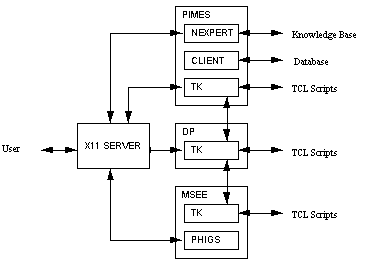3.2 THE DESIGN FOR MOLDING SYSTEM
3.2.2 THE DFM UTILITIES
The DFM system is an environment developed for PIMES to evaluate geometric models, to view the model and evaluation results, and to handle the information and processing requirements to achieve this. It consists of three independent utilities: the Design Processor (DP), PIMES, and MSee. Each of these utilities execute as independent processes, handling distinct aspects of the system. Table 5 below distinguishes the utilities and briefly describes their functions.
Table 5 DFM System Utilities
Utility Function
Polygonizer Converts IGES file to linearized Noodles solid model.
DDPF Differential Depth Perception Filter for feature extraction.
PIMES Plastic Injection Molding Expert System for knowledge-based evaluation, mold dimensioning, and machine selection.
DP Design Processor to manage information and applications and provide user interface to system.
MSee Enhanced "See" utility for interactive 3D visualization.
Figure 14 illustrates the DFM architecture in terms of its internal libraries. Each library provides a set of functions and abstractions which help to define the character of the utilities. Each utility is set up with the means to communicate with the others via messages in a client/server fashion. Commands available in one utility can be invoked by another utility. This is made possible by the inclusion of the ToolKit library (TK), developed by John Ousterhout of Berkeley University [Ousterhout 91]. TK provides inter-process communication, as well as a set of X11-based graphical items such as window frames, buttons, sliders, and menus. These items and their behavior can be declared in a ToolKit Command Language (TCL) script. The script is interpreted by the TK-comprising library and displayed upon the computer screen.
The PIMES utility applies rules to frame-based representations, extracting necessary data from the database. The Nexpert Object library provides the expert system engine, which reads in and processes the knowledge-based declaration of frames and rules. The Sybase library allows PIMES to be a client to the Sybase database server. Data is retrieved through the expert system engine to fill in the values of the frames.
While PIMES stands on its own as an application in knowledge-based development and execution, the utility is largely controlled by the Design Processor in the context of the DFM system. The Design Processor sends a series of messages to PIMES to set up the PIMES initial configuration and trigger rule processing.
The DP utility is responsible for completely managing the information and invoking the processes of Figure 14. As such, it is responsible for upkeep of the Noodles designs and associated representations of feature critiques, images, and other representations. In addition to this undertaking, the state of each model and its transformation are clearly and graphically conveyed to the user.
The MSee utility is an enhancement to the See utility. MSee is responsible for displaying the model image in an interactive, three dimensional environment, courtesy of the PHIGS display functions. The MSee utility is also responsible for textually displaying evaluations with the TK functions. As with PIMES, actions within MSee are initiated by the DP, as in being told what image to display and where to find it. However, MSee is entirely responsible for control over the manipulation of the image itself.
Figure 14 Independent Server Processes of the DFM System and their Library Functions
